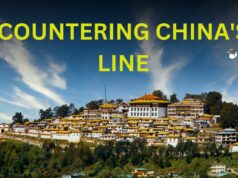Central Army Commander Exclusive Interview
The Indian Army Central Command, also known as Surya Command is headquartered in Lucknow. It guards a less focused but strategically important stretch of the Line of Actual Control (LAC) along China occupied Tibet. It also handles several historical and civilisation pilgrimage centres including the Char dhams (four holy places).
It’s a Himalayan region with as many as 26 high passes. But, this sector is not the centre of attention in border tension between India and China. For those who, perhaps, are unaware, China’s first known transgression across the disputed border happened at Barahoti . located in this sector in the 1950s.
Middle Sector Along LAC
Currently the Indian Army’s deployment is sparse along this stretch (middle sector) of the LAC (when compared to the western and eastern sectors). But, the areas under Central Command have historical trade and civilisational linkages to Tibet.
Before India and China signed the 1954 Panchsheel agreement, trade routes from Lipulekh and Shipki La as well as the route to the Holy Mansarovar and Kailiash Parvat used to happen from this area. Of late, the Indian Army has started concentrating on building adequate infrastructure and military strength in what is known as the middle sector along the LAC. In this candid conversation with Editor-in-Chief Nitin A. Gokhale, Lt Gen Anindya Sengupta, the Central Army Commander, elaborates on the role of the Surya Command. And the progress and development it is involved in currently, in an attempt to make life easier for border residents as well as beefing up India’s defences.
This is the first episode in our series, ‘LAC Logs: Along Himachal’s Himalayan Heights’. The series will have comprehensive coverage in documentaries and conversations from our team of Amitabh P. Revi, Aryaman Singh Negi and Vashisht Mattoo, who filmed extensively along the LAC in Surya Command’s Area of Responsibility (AoR). Deepankar Verma provides the graphics and maps.
Vibrant Villages
While driving home the importance of border areas in this sector, Lt Gen Sengupta points to an advantage India has over China. “We do not have to create new villages to populate this area; we already have a resident population here”. It is extremely important that we help them grow further economically, empower them, he adds. The Army works in close coordination with the civil administration to decipher what the locals want. That is so that development of infrastructure and the local economy are attuned to their needs.
Nitin A. Gokhale is a media entrepreneur, one of South Asia's leading strategic affairs analyst and author of over a dozen books so far on military history, insurgencies and wars.
Starting his career in journalism in 1983, he has since led teams of journalists across media platforms.
A specialist in conflict coverage, Gokhale has covered the insurgencies in India’s North-East, the 1999 Kargil conflict and Sri Lanka’s Eelam War IV between 2006-2009.
Gokhale now travels across the globe to speak at seminars and conferences, and lecture at India’s premier defence colleges. He has founded three niche portals, Bharatshakti.in, stratnewsglobal.com and Interstellar.news.




